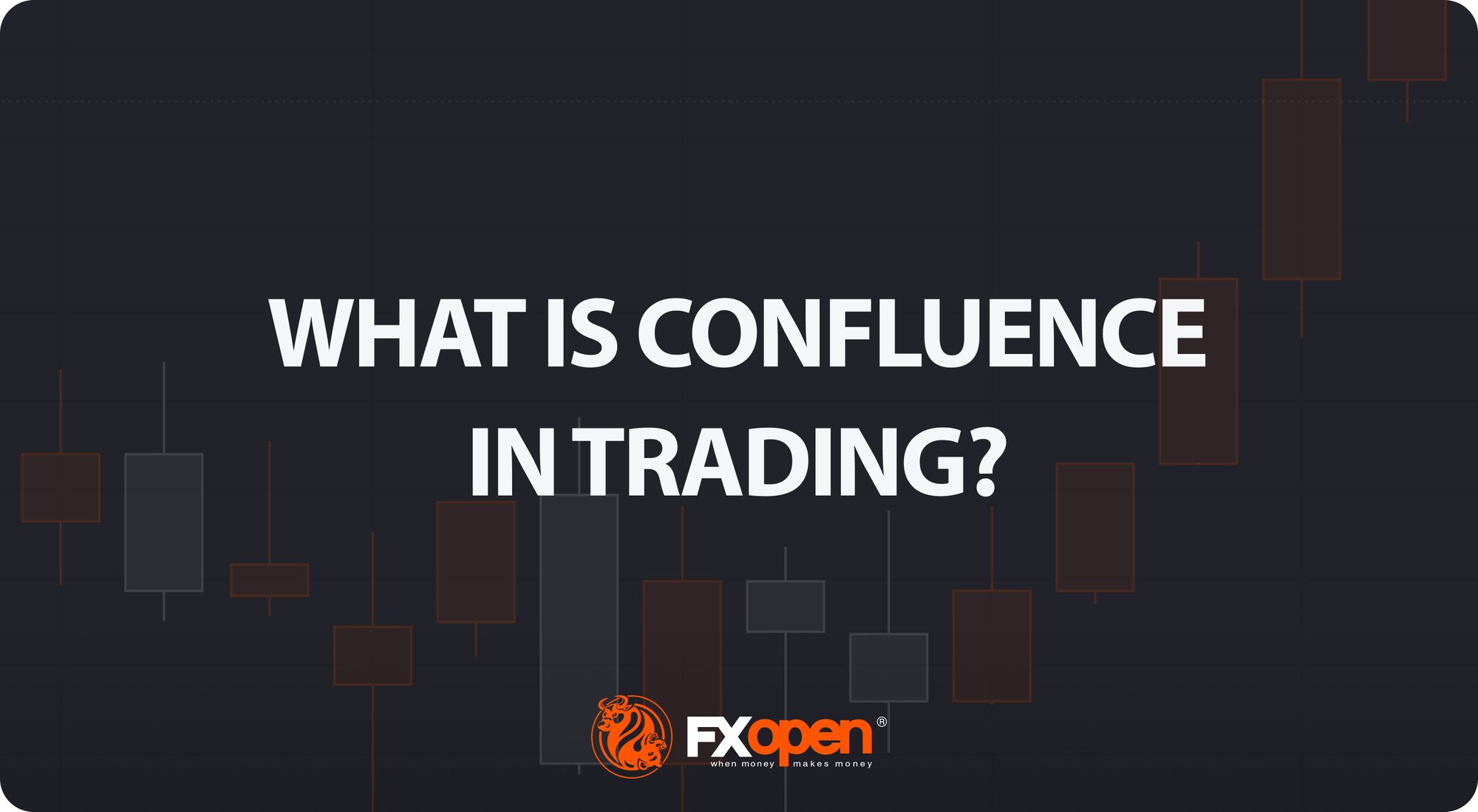FXOpen

Confluence in trading involves the strategic alignment of multiple signals to validate trade decisions. This method is supposed to enhance the reliability of trade signals and allows traders to filter out low-probability outcomes. This article delves into the key components of confluence trading, its practical applications, implementation, and common mistakes.
Confluence: Definition in Trading
Confluence in trading refers to the alignment of multiple indicators or analysis tools to get stronger signals for decision-making. By combining various technical indicators, chart patterns, and support and resistance levels, traders can filter out low-probability setups and focus on higher-probability outcomes.
For instance, confluence can involve using a moving average crossover, a support level, and an RSI reading below 30 to identify a potential buying opportunity. This multi-faceted approach helps validate the trade signal and potentially increases the likelihood of favourable outcomes.
The essence of confluence in forex trading and other assets is to provide a comprehensive view of the market, reducing false signals and offering a more reliable basis for decision-making. It acts as a confirmation mechanism, enhancing the accuracy of technical analysis and helping traders avoid overtrading by focusing only on trades with multiple supporting factors.
Key Components of Confluence in Trading
Confluence in trading can be sought from multiple sources, including technical indicators, chart patterns, support/resistance levels, and other analytical tools. Some of the common confluence tools include:
Indicator Signals
Technical indicators are essential in confluence trading. Indicators like moving averages, Bollinger Bands, Relative Strength Index (RSI), Average Directional Index (ADX), and VWAP can confirm the same trading signal, potentially increasing the likelihood of an effective trade. For instance, a bullish signal from the RSI and ADX’s signal of the solid trend can provide a stronger confirmation for entering a trade than relying on a single indicator.
Traders can discover a wealth of confluence indicators and start trading in over 600 markets at FXOpen’s free TickTrader trading platform.
Chart and Candlestick Patterns
Chart patterns, such as cup and handle, rounding top, and diamond, are among key tools in identifying potential market movements. Candlestick patterns like san-ku, tweezer top and bottom, and hook reversal also play a crucial role. These patterns provide robust confluence points when they align with other technical signals. For example, a bullish san-ku pattern at a support level can indicate a buy signal.
Support and Resistance Levels
Support and resistance levels, including horizontal lines, trendlines, and Fibonacci retracement levels, are foundational elements in technical analysis. These levels indicate where the price is likely to encounter obstacles. When a Fibonacci retracement level aligns with a horizontal support line and a rising trendline, it forms a strong point of confluence, suggesting a potential reversal or continuation of the trend.
Trend Analysis
Analysing the overall market trend offers key insights into market direction. Traders often use trendlines or examine the sequence of highs and lows forming the trend to identify the direction of the market. Combining trend analysis with other technical tools, such as indicators or support/resistance levels, can potentially enhance the effectiveness of trade signals. For instance, trading in the direction of a confirmed trend and using confluence from other indicators might improve trade effectiveness.
Higher-Timeframe Analysis
Higher-timeframe analysis involves looking at longer timeframes to validate signals seen on shorter timeframes. For example, a trend observed on a daily chart can provide context and validation for signals on an hourly chart. This method helps ensure that trades are aligned with the broader market trend, potentially reducing the chances of false signals.
Fundamental Analysis
Fundamental analysis, which includes economic indicators such as GDP, interest rates, and employment data, can be combined with technical analysis to strengthen trade signals. For instance, if technical indicators suggest a bullish trend and fundamental data supports economic growth, the confluence of these factors can provide a more reliable trade setup.
Time of Day
Market activity varies throughout the day, with certain periods experiencing higher volatility and liquidity. Understanding the impact of different trading sessions can help traders identify optimal times for trading. For instance, false signals may occur during quiet periods of the market when prices are most likely to range, while more active session overlaps can be seen as offering stronger and timely signals.
On the chart above, the New York session closed at 21:00 GMT (summer time) but the Sydney session didn't start. Therefore, the price of the AUD/USD pair ranged from 21:00 to 22:00.
Other Considerations
Ultimately, confluence isn't limited to the mentioned categories. Any analytical tool that a trader finds reliable can be integrated into their confluence strategy, including sentiment, positioning (for currencies, stocks, and indices, this can be derived from Commitment of Traders data), bull/bear traps, and Smart Money Concepts. The key is to ensure that the signals from different tools align and reinforce each other to create a robust and reliable trading setup.
Practical Applications of Confluence in Trading
Using confluence in trading is essentially about finding the optimal point where a manageable number of signals align, allowing for clear and quick decision-making. While leveraging too many indicators can result in conflicting signals and missed opportunities, relying on too few might not provide enough confirmation. The key is to develop a deep understanding of a few selected confluence factors that complement each other.
Optimising Confluence Factors
An ideal confluence setup uses a mix of different types of signals, such as those described in the categories above. For instance, a trader might focus on key support and resistance levels, combine them with an indicator or fundamental analysis, and understand the broader trend using higher timeframe analysis.
However, this also applies to indicators; most traders typically rely on two or three indicators of different types, such as a momentum indicator (e.g., RSI), a trend indicator (e.g., moving averages), and a volume-based indicator (e.g., On-Balance Volume). Such an approach can provide a balanced and effective strategy by seeking confirmation from varied sources and reducing the risk of conflicting signals.
Creating a Foundation for Confluence Trading
In practice, it is down to the individual trader to determine their ideal mix of confluence factors. However, to form an effective basis for confluence trading, it’s wise to prioritise three specific factors before considering more timely aspects like chart patterns and indicator signals.
- Top-Down Analysis: Markets are fractal, meaning that a lower timeframe trend is part of a higher timeframe trend. Using top-down analysis, where traders start from the highest timeframe and work downwards to the one most relevant to their trading, they can understand the broader market context and which higher timeframe trends may be directing lower timeframe trends. This holistic approach can ensure a trader stays on the right side of the market, following trends rather than fighting them.
- Support and Resistance Levels: Nearly all markets naturally move between support and resistance levels since historical areas where prices found a bottom or top are likely to influence future price movements. This means that traders usually prioritise trades in areas of support or resistance as a basis for trades instead of treating these levels as simply another confluence factor.
- Fundamental Analysis: Markets also move as fundamentals evolve. While it’s possible to create a strategy using just technical analysis, fundamentals will nearly always drive a currency, stock, or other asset’s price movements in the long run. Therefore, understanding the fundamental direction of an asset can form the basis of a trade that can then be confirmed with other confluence factors. Even if it isn’t the foundation of a trade, aligning yourself with the trend direction indicated by fundamental factors can help boost your chances of effective trading.
How to Get Started Using Confluence in Trading
To begin using confluence in trading, traders choose a few complementary forms of analysis to build out their strategy. For instance, combining top-down analysis, identifying support and resistance levels, and incorporating fundamental analysis or using two or three technical indicators can create a balanced approach without being overwhelming. Observing other traders' strategies can also provide valuable insights and ideas.
Defining Entry and Exit Signals
Once the strategy components are chosen, traders need to define the conditions that should be met before considering entry and exit points. For example, a bullish trade might require a higher timeframe uptrend, a pullback to a support level, and confirming signals from a technical indicator.
These factors alone may be enough for a trade, while some may prefer to wait for a specific entry signal, such as a bullish candlestick pattern, to initiate the trade. It’s also important to consider and implement risk management practices to potentially limit losses.
Backtesting and Forward Testing
The next step involves backtesting and forward-testing the strategy. Backtesting can be performed using tools like TradingView's bar replay feature, allowing traders to simulate trades on historical data.
While technical aspects can be thoroughly backtested, incorporating fundamental analysis in backtesting can be more challenging. When a trader is confident that their strategy shows positive results over a substantial number of trades (typically 50 to 100), they proceed to forward testing.
Forward testing involves executing trades in real time using a demo account, which poses no risk to actual capital. This stage helps traders understand how their strategy performs under real market conditions, including factors like slippage and liquidity. It also allows them to gauge their emotional responses and discipline during live trading. If the strategy proves too complex or requires refinement, traders can make necessary adjustments before risking real money.
Common Mistakes to Avoid When Using Confluence Strategy
Confluence trading can enhance trading strategies by combining multiple signals to validate trade setups. However, traders must be cautious to avoid common pitfalls that can undermine the effectiveness of this approach.
1. Overcomplicating Analysis
Using too many tools can lead to analysis paralysis, where conflicting signals cause confusion and indecision. It's best to focus on a few complementary tools to streamline analysis and maintain clarity in decision-making.
2. Ignoring Market Context
Relying solely on technical indicators without considering the broader market context can lead to false signals. To make well-rounded trading decisions, it's essential to analyse the overall trend, support and resistance levels, and other relevant market conditions.
3. Neglecting Fundamental Analysis
While technical analysis is powerful, ignoring fundamental factors can result in missed opportunities or unexpected losses. Combining technical signals with fundamental analysis, such as economic data and news, provides a more comprehensive view of the market.
4. Overtrading
Trading too frequently, often in an attempt to recover losses or maximise returns, can lead to impulsive decisions and increased risk. Focusing on quality over quantity and sticking to the specific confluence factors you’ve outlined helps maintain discipline and improve the odds of the long-term effectiveness of your trading approach.
5. Poor Risk Management
No matter how many confluence factors align, they will inevitably fail at some point—no strategy is 100% correct. It’s, therefore, crucial to establish and adhere to a risk management plan, including setting appropriate stop-loss levels and position sizes to potentially protect capital.
The Bottom Line
Mastering confluence in trading enhances decision-making and potentially increases the likelihood of effective trades. By integrating multiple signals and robust analysis, traders might achieve more consistent results. Start applying these strategies today by opening an FXOpen account, where you can practise and refine your confluence techniques in over 600 markets with more than 1200 trading tools.
FAQs
What Is a Confluence in Trading?
The confluence meaning in trading refers to the alignment of multiple technical indicators, chart patterns, and other analysis tools to confirm a trade signal. This approach potentially increases the probability of effective trades by validating signals from different sources, making trading decisions more reliable and robust.
What Are the Factors of Confluence in Trading?
Factors of confluence in trading include technical indicators like moving averages and RSI, chart patterns such as a diamond, support and resistance levels, trendlines, and fundamental analysis. By combining these elements, traders can identify high-probability trade setups and potentially reduce the risk of false signals.
What Is the Point of Confluence?
A point of confluence is where multiple technical and fundamental indicators align, confirming a potential trade setup. This potentially increases the likelihood of an effective trade outcome, as it signals that various forms of analysis reflect the same market movement.
What Is a Confluence Zone?
A confluence zone is an area on a price chart where multiple technical indicators and analysis tools converge, creating a strong signal for potential price movement. These zones often mark significant support or resistance levels and provide traders with key entry and exit points.
What Is the Confluence Trading Strategy?
The confluence trading strategy involves combining different technical and fundamental analysis methods to validate trade signals. Traders look for areas where multiple indicators align, potentially enhancing the accuracy of their trades. This approach helps traders filter out low-probability setups and focus on high-probability opportunities, potentially improving overall trading performance.
This article represents the opinion of the Companies operating under the FXOpen brand only. It is not to be construed as an offer, solicitation, or recommendation with respect to products and services provided by the Companies operating under the FXOpen brand, nor is it to be considered financial advice.
Stay ahead of the market!
Subscribe now to our mailing list and receive the latest market news and insights delivered directly to your inbox.








